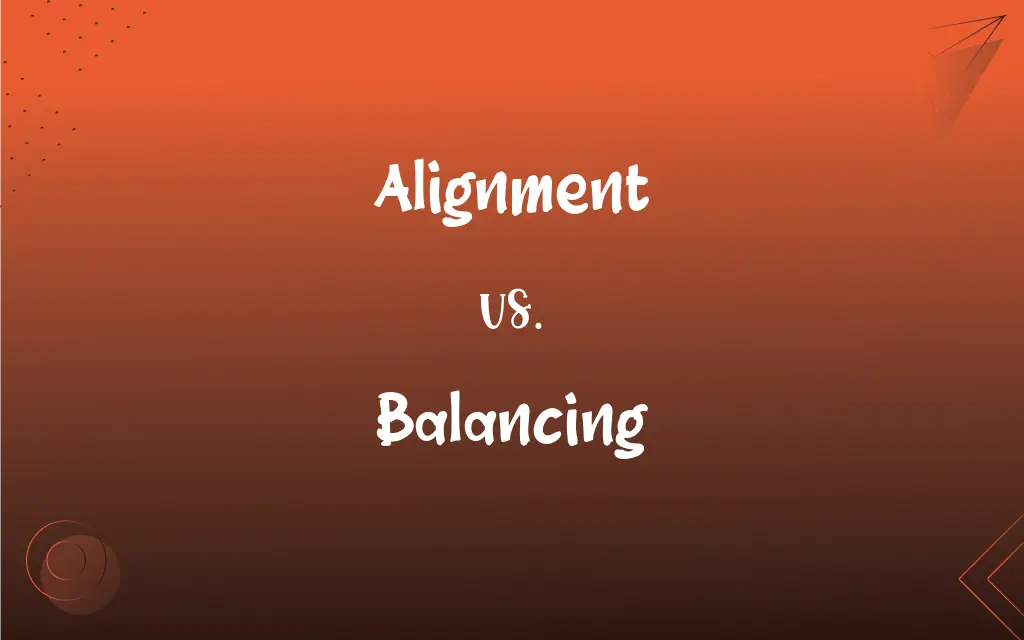Alignment vs. Balancing: What's the Difference?
Edited by Janet White || By Harlon Moss || Updated on October 13, 2023
Alignment is an arrangement in a straight line or in correct relative positions. Balancing refers to establishing equilibrium or equal distribution of weight.

Key Differences
This pertains to the orderly arrangement of things in a straight line or parallel lines, emphasizing uniformity and rectilinear precision. Balancing, however, is fundamentally concerned with ensuring stability and uniformity in weight distribution, independent of linearity or order.
Balancing involves ensuring that different elements are given equal weight or importance, facilitating stability or symmetry. Whereas alignment might pertain more to the orderly positioning or arrangement of items in a line or in relation to one another, without necessarily ensuring equilibrium.
In some contexts, alignment might imply a kind of agreement or cooperation, such as political or ideological alignment, which is distinct from balancing. Balancing does not imply agreement or cooperation but focuses on equal distribution or stability across various elements.
When we talk about balancing, especially in a mechanical context, it involves adjusting the mass of a device intentionally to improve its stability and control. Whereas alignment might involve adjusting various elements to ensure they’re linearly or relatively properly arranged.
In a technological or data management context, alignment might refer to the proper arrangement or lining up of data, text, or other variables. In contrast, balancing doesn’t have to align elements in a straight line but ensures even weight or importance across diverse elements.
ADVERTISEMENT
Comparison Chart
Basic Definition
Arranging in a straight or parallel line.
Ensuring equal weight or distribution.
Implication
Implies order and uniformity in arrangement.
Implies stability or symmetry.
Contextual Use
Often used in spatial, political contexts.
Commonly used in physical, emotional contexts.
Requirement
Does not require equal weight distribution.
Does not necessitate linear arrangement.
Objective
Aims for orderly or coordinated positioning.
Aims for equilibrium and stability.
ADVERTISEMENT
Alignment and Balancing Definitions
Alignment
Alignment also implies alliance or cooperation, especially in ideological or political contexts.
Their alignment with the political party was strategic.
Balancing
Balancing involves equalizing different elements to create stability or harmony.
Balancing the competing needs was a challenging task for the manager.
Alignment
Alignment refers to the arrangement in a straight line or in correct relative positions.
The alignment of the stars was a breathtaking sight.
Balancing
In finance, balancing pertains to equalizing credits and debits in accounts or transactions.
Balancing the budget required stringent financial oversight.
Alignment
In data or computing, alignment involves arranging data to coincide with data blocks or specified formats.
The binary data's alignment was crucial for efficient memory usage.
Balancing
Balancing in chemistry implies maintaining equal quantities of mass in a chemical equation.
Chemists use coefficient numbers for balancing chemical equations.
Alignment
In spirituality or metaphysics, alignment might refer to a congruence or harmony between beliefs, actions, and universal energies.
Through meditation, he sought alignment with the universe.
Balancing
In mechanics, balancing refers to distributing weight evenly to maintain equilibrium and prevent tilting.
Balancing the tires of a vehicle ensures a smooth ride.
Alignment
In orthodontics, alignment pertains to the orderly arrangement of the teeth for optimal occlusion.
After a year of braces, her teeth were in perfect alignment.
Balancing
In a general context, balancing can mean offsetting or counteracting one factor against another to avoid dominance.
Balancing work and life demands strategic planning and prioritization.
Alignment
Arrangement or position in a straight line or in parallel lines.
Balancing
A weighing device, especially one consisting of a rigid beam horizontally suspended by a low-friction support at its center, with identical weighing pans hung at either end, one of which holds an unknown weight while the effective weight in the other is increased by known amounts until the beam is level and motionless. Also called scale.
Alignment
The process of adjusting parts so that they are in proper relative position
A set of gears needs periodic alignment.
Balancing
A state of equilibrium or parity characterized by cancellation of all forces by equal opposing forces.
FAQs
Can balancing be used in discussing work and life?
Absolutely, discussing balancing work and life involves managing priorities to achieve stability and fulfillment.
What does alignment mean?
Alignment refers to arrangement in a straight line or correct relative positions.
Does alignment in data management involve organizing data?
Yes, data alignment involves organizing data in a specified or orderly manner.
Can balancing relate to financial management?
Yes, balancing often refers to managing credits and debits to maintain financial equilibrium.
Does alignment always ensure stability?
Not necessarily. Alignment ensures order but not always stability or equilibrium.
Is balancing always about physical weight?
No, balancing can involve varied elements, like emotions, finances, or other non-physical aspects.
Does alignment in design improve usability?
Often, yes. Alignment in design can enhance clarity, readability, and overall user experience.
Is balancing related to stability?
Yes, balancing generally seeks to achieve stability through equal distribution or counteraction.
Can alignment refer to cosmic or astronomical positions?
Yes, alignment can describe the orderly arrangement of stars, planets, or other celestial bodies.
Does balancing imply making things equal?
Balancing involves making elements equal or proportionate, often to create stability or harmony.
Can alignment involve data in computer science?
Yes, alignment in computing often pertains to data arrangement in memory or storage.
Can balancing refer to dietary habits?
Yes, balancing can pertain to managing and equalizing nutritional intake in a diet.
Does alignment ensure equilibrium?
Alignment does not inherently ensure equilibrium but focuses on orderly arrangement.
Can alignment refer to ideological similarity?
Yes, alignment can imply ideological or political cooperation or similarity.
Can alignment be related to aesthetics?
Yes, alignment, especially in design, can be crucial for visual aesthetics and order.
What is the essence of balancing?
Balancing involves establishing equilibrium or equal distribution of weight or importance.
Is alignment only physical or spatial?
No, alignment can refer to physical positioning, but also to metaphorical, political, or ideological arrangement.
Can balancing involve emotions?
Yes, balancing can relate to managing and stabilizing emotional or psychological states.
Is balancing relevant in chemistry?
Yes, in chemistry, balancing involves ensuring chemical equations have equal mass on both sides.
Is balancing related to symmetry?
Yes, balancing can involve establishing symmetry among varied elements or sides.
About Author
Written by
Harlon MossHarlon is a seasoned quality moderator and accomplished content writer for Difference Wiki. An alumnus of the prestigious University of California, he earned his degree in Computer Science. Leveraging his academic background, Harlon brings a meticulous and informed perspective to his work, ensuring content accuracy and excellence.
Edited by
Janet WhiteJanet White has been an esteemed writer and blogger for Difference Wiki. Holding a Master's degree in Science and Medical Journalism from the prestigious Boston University, she has consistently demonstrated her expertise and passion for her field. When she's not immersed in her work, Janet relishes her time exercising, delving into a good book, and cherishing moments with friends and family.































































